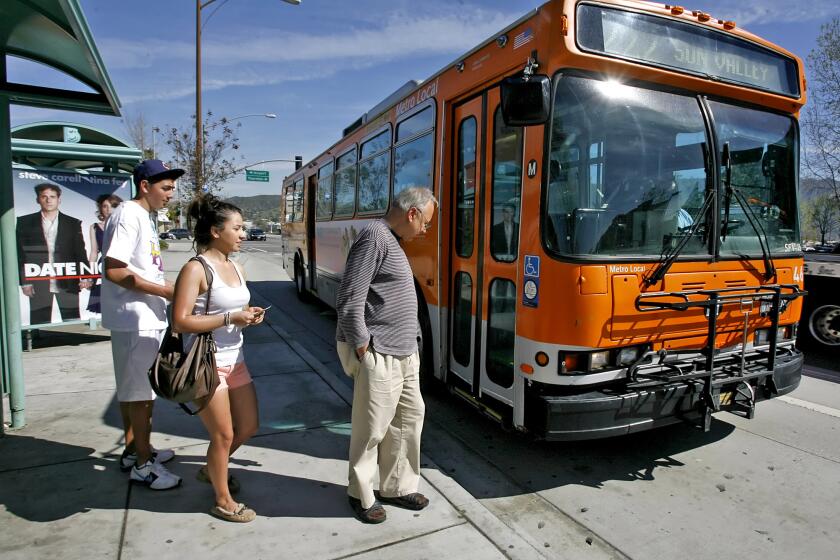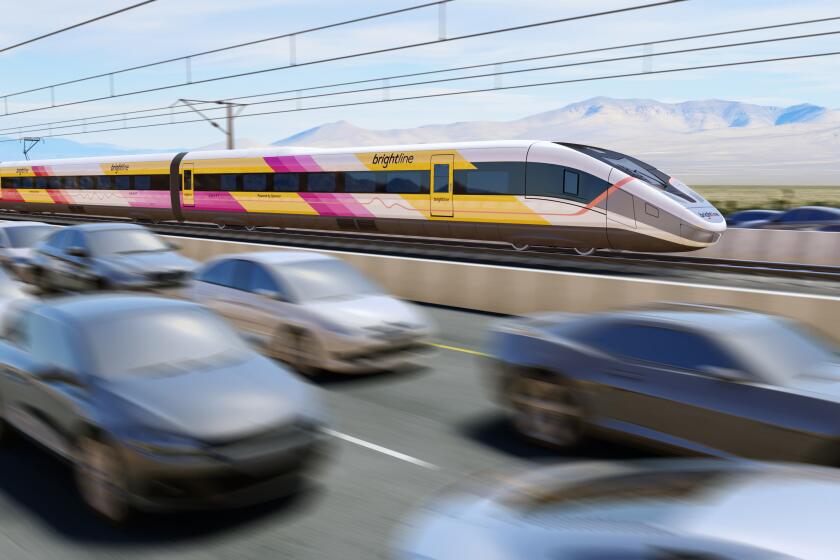High-Tech Eyes Keeping Watch on City’s Roadways
Like many drivers, Beth Lumetta gives little thought to the string of traffic lights at all those intersections that she encounters each day.
“I like it when they’re green, not when they’re red -- that’s about it,” said the Studio City office manager, who often travels on city streets to avoid freeway congestion.
But behind many of the simple-looking dots of shining green, yellow and red across the cityscape, an elaborate high-tech system is helping to reduce congestion.
Since the 1980s, the Los Angeles Department of Transportation has been equipping intersections across the city with sensors that synchronize and coordinate traffic lights through a centralized computer network. The system has become one of the city’s primary means of getting more traffic through its jam-packed streets.
Because most thoroughfares are flanked by buildings and sidewalks, there is little room to widen them to accommodate increasing traffic. Therefore, controlling traffic lights has become an important way for traffic engineers “to maximize the roadway, to make sure there is no waste in the system,” said John E. Fisher, assistant general manager of the transportation department.
Years ago, the most advanced methods for controlling traffic involved equipping lights with timers that flipped colors according to a preset schedule, and any changes had to be manually reset.
These days, the city’s most sophisticated intersections collect real-time information and have signals that automatically adapt to changing roadway conditions to make vehicle flow smoother and reduce stop-and-go traffic.
“It’s on the cutting-edge of strategies we have.... It’s one of the most cost-effective tools ... to manage congestion,” said Alex Skabardonis, an adjunct professor and research engineer at UC Berkeley’s Institute of Transportation Studies who specializes in intelligent transportation systems and traffic operations. “L.A. has perhaps the best system in the country.”
Of the city’s 4,300 intersections, about 3,000 are already part of the centralized computer system. About 200 of the networked crossings are also equipped with traffic surveillance cameras.
Communities that already have computer-coordinated traffic lights include downtown, Boyle Heights, West Los Angeles, Hollywood, Silver Lake, portions of South Los Angeles and the south San Fernando Valley along the Ventura Boulevard corridor.
Under construction now is a project on Sepulveda Boulevard, between Sherman Oaks and Westwood.
Running roughly parallel to the San Diego Freeway, Sepulveda is one of the most heavily traveled routes in the city, with some segments carrying as many as 35,000 vehicles a day, according to the transportation department.
Near the Getty Center on Sepulveda on a recent morning, a work crew driving a tractor-like “earth saw” machine and bearing shovels dug up pavement to embed sensors, install a camera and carve out a long, narrow trench more than a foot deep down the length of the curvy canyon road. The gutter, which will eventually be paved over, will hold copper cables and fiber-optic lines connecting the sensors and the camera to the transportation department’s downtown traffic control center.
The sensors not only will be able to count the number of cars traveling up and down the Sepulveda corridor, but also gauge their speeds and alert downtown computers -- and the city traffic engineers monitoring them -- whenever there is sudden congestion.
With cameras sending images to large screens at the control center, traffic engineers can determine the cause of the congestion and whether they should intervene. If there were an accident, police and tow trucks would be called, Fisher said.
Engineers at the command center also can override computers to manually adjust traffic lights -- prolonging red lights on certain streets, for example, to discourage drivers from entering a congested area and causing gridlock.
The Sepulveda project, which began in November and is scheduled to be completed in May, will equip 27 intersections with sensors and nine with cameras. The improved coordination means the oft-congested thoroughfare will be able to carry 10% more cars during peak hours, said James Okazaki, an assistant general manager for the transportation department.
The agency estimates that citywide, the system has reduced rush-hour delays by 20%.
In the next couple of years, communities scheduled to receive traffic-signal upgrades include those in the Ronald Reagan Freeway corridor, Eagle Rock, Exposition Park, Westchester and the central San Fernando Valley along the San Diego Freeway.
But because of the state budget crisis and reduced levels of state transportation funding, projects planned for Canoga Park, North Hollywood and Reseda will likely be delayed two or three years, and groundbreaking in those areas may not begin until 2007 or 2008.
The city’s goal, Fisher said, is to eventually link all of its traffic signals to the centralized system.
If you have a question, gripe or story idea about driving in Southern California, write to Behind the Wheel c/o Los Angeles Times, 202 W. 1st St., Los Angeles, CA 90012, or send an e-mail to behindthewheel@latimes.com.
More to Read
Start your day right
Sign up for Essential California for news, features and recommendations from the L.A. Times and beyond in your inbox six days a week.
You may occasionally receive promotional content from the Los Angeles Times.






